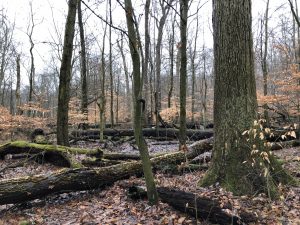Nature has a way of sending us signs. When the leaves on trees turn up and the wind changes and the animals become scarce, we know a storm is coming. When walking through the woods to see an increasing presence of peat moss, we know we are approaching a bog, but I am led to wonder what about peat moss links it to the wet environment of Brown’s Bog. Peat, or sphagnum, moss has adapted its structure to the watery habitats in which it is found. The water supports the plant, so it does not need strengthening structures, meaning wet places are where the moss can grow and thrive most efficiently. Tangentially—but still interestingly—at its base, sphagnum moss is decaying and dying, while is base is made up of a stem and branches that foster photosynthesizing leaves. Further, as we witnessed in Brown’s Bog, peat moss makes up a forest floor that is supple and rubbery. It has come to be known as a “habitat manipulator” for its effect on the atmosphere, adding significant amounts of hydrogen and its ability to spread into drier environments and provide habitat for many peatland plants, including carnivorous plants like the pitcher plant we saw in the bog. What this microcosm shows us is the great influence one aspect of the environment bears on all its surroundings, even so far as to say the power the part has over the whole. And even as the root of the moss is dying, the species is fostering new life.
Evil in Thoreau’s “Economy”
Thoreau evokes Shakespeare to make a claim on what in human life he views to be “evil”. Reflecting on “the auction of a deacon’s effects” (155), Thoreau borrows from The Tragedy of Julius Caesar: “The evil that men do lives after them. ” He elaborates that the evil, for his purposes, are those effects that are left behind, and those items are auctioned off in such a way that increases their value in a manner that seems to exploit the death of a man. Thoreau illustrates, “The neighbors eagerly collected to view them, bought them all, and carefully transported them to their garrets and dust holes” (155). Thoreau seems to find despicable the tendency of fellow man to value objects over living beings, and he highlights this perversity by providing his readers with the image of people eagerly going after the objects Thoreau claims to be the “evil” of man. In such an illustration, Thoreau also succeeds in categorizing the majority of humankind as “evil” for their enthusiastic pursuit of such “evil” material.
Further, the second clause of the Shakespearean quote which Thoreau omits concludes, “The good is oft interred with their bones”. Consideration of this quotation augments the categorization of things as bad and people, their being and essence, as good–emphasizing Thoreau’s value of the individual over the value of the materials we possess.
Thoreau’s Use of Nature
Different from our view of nature as something to be preserved and untouched, Thoreau believes nature is something we should use in our effort to live simply. He uses the bean field as a simpler means to produce one’s own food without feeding into a mass-producing society. He also claims to “love [his] rows,” saying, “They attached me to the earth, and so I got great strength like Anteaus” (Walden 219). He uses his bean field as a conduit through which to connect to the ground beneath his feet and establish a transcendent connection to his simple self. Still, Thoreau acknowledges the potentially exploitative behavior, asking, “But what right had I to oust johnswort and the rest, and break up their ancient herb garden?” (Walden 220). The content of this question indicates Thoreau’s awareness of his disruptive presence, something we have discussed at length in class. By phrasing it as a rhetorical question, Thoreau invites his reader(s) to contemplate that question for themselves, while also, perhaps, reflecting his own lack of an answer. Regardless, this stylistic choice enhances the quality of Thoreau’s journal, as it maintains his authenticity of thought while he is living and working by Walden Pond.
Life’s Lesson: A Journal From Johnson’s Woods

Nature does not shrink from its deceased. She does not fear the inevitable. That which dies is not frantically covered or removed. It is recognized, and it remains. Of course, this has a great deal to do with nature’s inability to grasp a shovel and dig a grave, her lack of will to pick up and settle elsewhere. She cannot run away, so she must cope. And she does so with grace. The dead become a part of the living. Necessary for continuity and for balance. Snags become hovels for woodpeckers and opossums. Trees completely fallen provide shelter for ground-dwellers and food for beetles. There is a great juxtaposition, then, of the thriving and decaying. All cycles and stages of life are commemorated in the world untouched by man. And I think we have something to learn.
